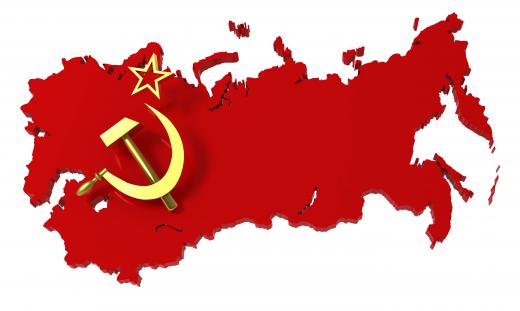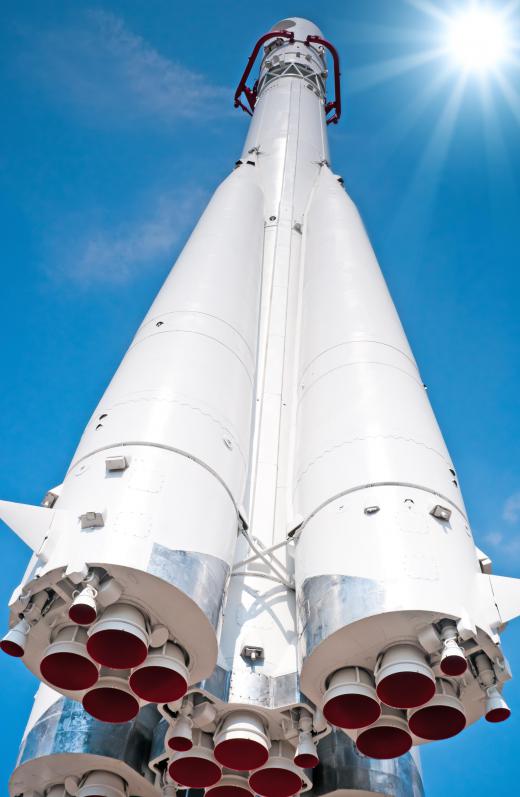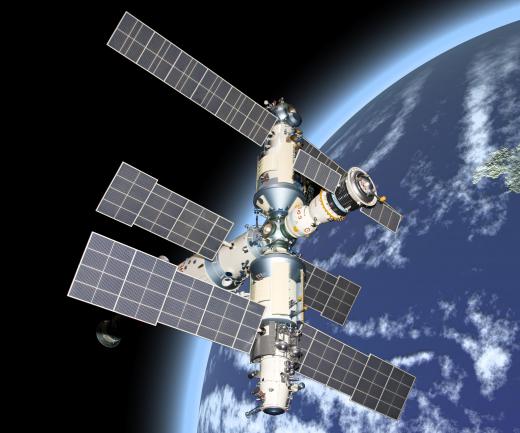What Was the First Space Station?
 Michael Anissimov
Michael Anissimov
Like many other firsts in space exploration, the first space station was launched by the Soviet Union. Like quite a few other space stories, it ended in tragedy. Launched on 19 April 1971, just two years after the Americans landed on the Moon, Salyut 1 was a 15.6 by 4 meter (51.18 by 13.12 feet) cylinder with 99 cubic meter (3,496.15 cubic feet) of interior space — similar to the size of a school bus. The space station had a dry weight of 18,425 kg (40,620 pounds), and was launched from the Baikonur Cosmodrome in present-day Kazakhstan.
The purpose of Salyut 1 was to put into orbit the first manned facility for long-term research and observation. It was designed both as a proof of concept for space stations in general and to conduct experiments and observations which satellites could not perform on their own. Salyut is one of nine space stations that have ever been inhabited as of November 2007.

The space station had four compartments, three of which were pressurized. These included the main compartment, a transfer compartment, auxiliary compartment, and storage compartment. Like all other space stations launched thus far, it was launched crewless, and the crew arrived later via a separate vehicle.
Unfortunately, using the new space station was problematic from the start. Soyuz 10 launched on 23 April 1971, planning to be the first space station visit in history. Although the capsule docked physically with the station, the connection was not secure enough to allow the hatches to be opened without risking a leak into vacuum. It appeared that the hatches inside the Soyuz were jammed, anyway. The cosmonauts were forced to return to Earth without ever entering the station. As an additional complication, toxic fumes flooded the capsule upon reentry, causing one of the cosmonauts to pass out, although all three ultimately survived the ordeal without any further injuries.

The second attempt at visiting the station, Soyuz 11, was even less successful. Launched 6 June 1971 from Baikonur, the capsule did dock with the station and three cosmonauts made it inside, becoming the first people to visit a space station. They stayed there 22 days, a record for duration in space at the time. Cosmonaut Viktor Patsayev became the first person to use a telescope in space.

The disaster happened during reentry. After an apparently normal reentry, the recovery team opened the capsule and found all the cosmonauts dead. The flaw was traced to a breathing valve between the descent module and the orbiting module. Some explosive bolts, which were meant to fire sequentially, instead fired simultaneously, disrupting a seal on the valve. Pressure was lost at 168 kilometers (104 miles), and the cosmonauts suffocated when the air escaped from the cabin. They could have been saved if they wore pressure suits on the descent, as is now standard for all in-orbit transfer operations and reentry.

The three cosmonauts who died remain heroes to space enthusiasts everywhere. Their death underscores the danger of space travel, and the need to develop extremely safe systems before it becomes possible for larger portions of mankind to take steps into the cosmos.
AS FEATURED ON:
AS FEATURED ON:














Discussion Comments
I don't remember this news bit at all, but I did come across it when we were talking about the space program in U.S. history.
I remember Skylab very clearly. There were all kinds of photos and lots of film clips from videos taken on the space station.
I also remember when Skylab finally left orbit and crashed to earth. Seems like the largest piece was found in Australia. I do know they had it on stage at the Miss Universe pageant that year. Funny what you remember about these things. But it was a really big deal. There was some consternation about how big the pieces would be and whether they posed a threat to anyone on earth.
Seems like I vaguely remember that about the three cosmonauts when it happened, although I may be remembering hearing the news later on. I'm sure the Russians weren't forthcoming about media coverage of a failed mission. Makes me wonder how Tass handled the news at the time. I'd like to see an English translation of what the press had to say about it when it happened.
Not that the US hasn't had its share of tragedies in space: Apollo 1, Challenger, Columbia... and almost, Apollo 13. We have had enough astronaut deaths to make us cautious about how we proceed.
Post your comments